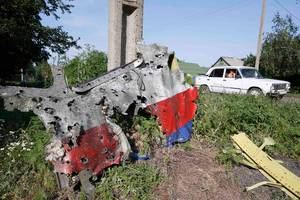 |
| Evidence of gunfire at the cockpit |
All the blah-blah about Buk missiles and who owns them was just a smokescreen. The availble evidence from the ground shows that the airplane was shot down with machine gun fire, which could only originate in the two Ukrainian fighter jets that were "escorting" the civilian flight.
Veteran pilot Peter Haisenko wrote an article for Global Research on the matter. He says about the only available high resolution image of the remains (→ PDF format):
The facts speak clear and loud and are beyond the realm of speculation: The cockpit shows traces of shelling! You can see the entry and exit holes. The edge of a portion of the holes is bent inwards. These are the smaller holes, round and clean, showing the entry points most likely that of a 30 millimeter caliber projectile.
The SU-25 machine guns use 30mm ammo of two types, one splinter explosive (dum-dum) and the other anti-tank incendiary, intercalated so they maximize the possible damage.
Because the interior of a commercial aircraft is a hermetically sealed pressurized chamber, the explosions will, in split second, increase the pressure inside the cabin to extreme levels or breaking point. An aircraft is not equipped for this, it will burst like a balloon. This explains a coherent scenario.
While the OSCE is not being as specific, the descriptions so far do match the reconstruction by Haisenko:
Michael Bociurkiw of the OSCE group of monitors at his daily briefing described part of the plane’s fuselage dotted with “shrapnel-like, almost machine gun-like holes.”
Some have tried a last-ditch defense of the Buk missile hypothesis arguing that the holes could have been also caused by shrapnel from such a missile (not a direct hit in any case) but this is contradictory with the evidence as well because there are not just entry holes but also exit ones and the entry holes are very round, as correspond to bullets, not chaotically produced shrapnel.
Please follow the in-like links for further information.
Another odd feature is Kiev air traffic control lost radio contact before MH17 was hit and asked a nearby Air India airliner to try and contact them but they got no response either.
ReplyDeletehttp://www.news24.com/Travel/Flights/Air-India-plane-only-90-seconds-away-from-MH17-tried-to-make-contact-20140721
Very strange.
The report doesn't say that, as you claim, they "lost radio contact before MH17 was hit", not at all. It says that they lost radio contact and asked a nearby Indian plane to try communication, which failed. If true, then it happened when the MH17 was downed and not "before".
DeleteAnyhow Indian aviation ministry denies it all (last paragraph of your source), what again raises the issue of Kiev's credibility or rather lack of it.